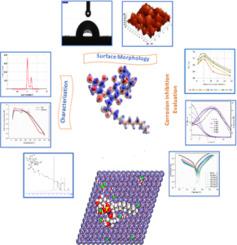Journal of Molecular Liquids ( IF 5.3 ) Pub Date : 2020-09-21 , DOI: 10.1016/j.molliq.2020.114382 S.J. Hepziba Magie Jessima , Avni Berisha , Subramanian Sathy Srikandan , Subhashini S.

|
The polar head and a hydrophobic long alkyl chain end of surfactants show effective adsorption on the metal surfaces and metal/solution interfaces. The present study deals with the investigation of corrosion inhibition efficiency of chitosan modified with an anionic surfactant, namely sodium lauryl sulfate. The modified chitosan was characterized using spectral techniques such as ATR- FTIR and NMR, thermal analytical methods that include TGA and DSC. The surface charge and particle size distribution were analyzed using Zeta potential analyzer. The corrosion inhibition efficiency of the water-soluble modified chitosan was evaluated using gravimetric and electrochemical methods. A maximum corrosion inhibition efficiency of 96.44% for 6 h of immersion period at 303 K was obtained. The adsorption process obeyed Langmuir isotherm. The adsorption mechanism involved both physisorption and chemisorption. Tafel and impedance studies showed results in agreement with the gravimetric method. Tafel plot indicates the inhibitor controlled both cathodic hydrogen evolution and anodic metal dissolution reactions. AC impedance study supports the increase in surface coverage of the metal surface by the inhibitor, forming a protective film. Further evidence comes from the surface characterization of the inhibited metal surface by contact angle measurement, SEM, EDAX spectra, and atomic force microscopic studies. DFT and Monte Carlo simulation studies showed a proper alignment with the experiment results.
中文翻译:

月桂基硫酸钠改性壳聚糖在酸洗过程中对低碳钢的制备,表征和缓蚀性能评价
表面活性剂的极性头和疏水性长烷基链端在金属表面和金属/溶液界面上显示出有效的吸附。本研究涉及用阴离子表面活性剂,即十二烷基硫酸钠改性的壳聚糖的缓蚀性能的研究。使用光谱技术(例如ATR-FTIR和NMR)以及包括TGA和DSC的热分析方法对改性的壳聚糖进行了表征。使用Zeta电势分析仪分析表面电荷和粒度分布。使用重量分析法和电化学方法评估水溶性改性壳聚糖的缓蚀效率。在303 K的浸入时间6 h,获得的最大腐蚀抑制效率为96.44%。吸附过程遵循Langmuir等温线。吸附机理涉及物理吸附和化学吸附。Tafel和阻抗研究表明结果与重量法一致。Tafel图表明抑制剂控制了阴极的氢逸出和阳极金属溶解反应。交流阻抗研究支持抑制剂增加金属表面的覆盖率,从而形成保护膜。进一步的证据来自通过接触角测量,SEM,EDAX光谱和原子力显微镜研究对被抑制的金属表面进行的表面表征。DFT和蒙特卡洛模拟研究表明与实验结果正确匹配。Tafel图表明抑制剂控制了阴极的氢逸出和阳极金属溶解反应。交流阻抗研究支持抑制剂增加金属表面的覆盖率,从而形成保护膜。进一步的证据来自通过接触角测量,SEM,EDAX光谱和原子力显微镜研究对被抑制的金属表面进行的表面表征。DFT和蒙特卡洛模拟研究表明与实验结果正确匹配。Tafel图表明抑制剂控制了阴极的氢逸出和阳极金属溶解反应。交流阻抗研究支持抑制剂增加金属表面的覆盖率,从而形成保护膜。进一步的证据来自通过接触角测量,SEM,EDAX光谱和原子力显微镜研究对被抑制的金属表面进行的表面表征。DFT和蒙特卡洛模拟研究表明与实验结果正确匹配。和原子力显微镜研究。DFT和蒙特卡洛模拟研究表明与实验结果正确匹配。和原子力显微镜研究。DFT和蒙特卡洛模拟研究表明与实验结果正确匹配。











































 京公网安备 11010802027423号
京公网安备 11010802027423号